Samsung Gear Fit Review
Samsung Gear Fit
This is not the gear to get you fit... but you can drop it down an elevator shaft
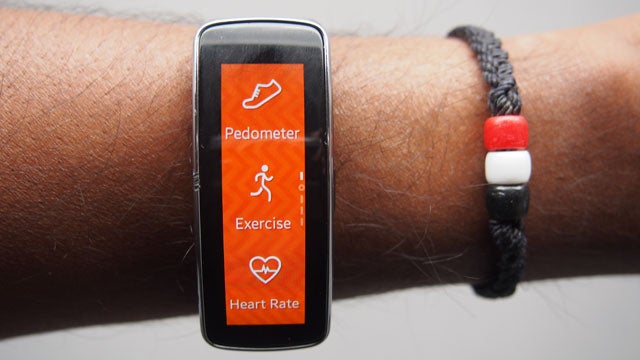
Sections
- Page 1 Samsung Gear Fit Review
- Page 2 Features & Performance Review
- Page 3 Battery Life, Performance and Verdict Review
Verdict
Pros
- Nice, bright display
- Heart rate integration for exercise activities
- Useful media controller
Cons
- Poor battery life
- Data-logging issues with S Health
- Sleep tracking not very insightful
- Heart rate sensor is temperamental
Key Specifications
- Review Price: £169.00
- 1.84-inch curved Super AMOLED display
- IP67 dust and water resistant
- Inbuilt heart rate sensor
What is the Samsung Gear Fit?
The Samsung Galaxy Gear Fit is a cross between a fitness tracker and a smartwatch. That means you have the ability to monitor and log daily activities, like walking or cycling, and get smartphone functionality like the ability to reject incoming calls or control music.
It beats the Sony Smartband and the LG LifeBand Touch as the first fitness band to arrive from the major tech players taking on usual fitness tracking suspects like Jawbone, Nike and Fitbit.
There’s no doubting this is one of the best-looking fitness trackers, but it’s definitely a case of style over substance when you strap it on and start using it.
SEE ALSO: Best Fitness Tracker 2014: 5 Best Activity Trackers
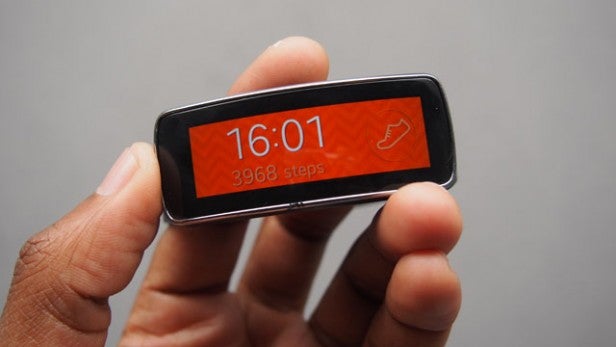
Samsung Gear Fit: Design
The original Samsung Galaxy Gear smartwatch is arguably one of the best-looking products the Korean company has made in recent years and thankfully the Gear Fit continues in the same vein.
The first thing that stands out is the curved AMOLED touchscreen display that dominates the Gear Fit design. The 1.84-inch display dwarfs the 1-inch display on the Garmin Vivofit and the non-touchscreen OLED display on the Fitbit Force.
It does make the Fit significantly wider in comparison to trackers like the Jawbone UP24 and is in fact closer in size to the Nike Fuelband SE. It’s definitely more watch-like than fitness tracker and people will certainly notice you wearing it.
SEE ALSO: Samsung Gear S2 vs Apple Watch: Do you go Apple or Samsung smartwatch?
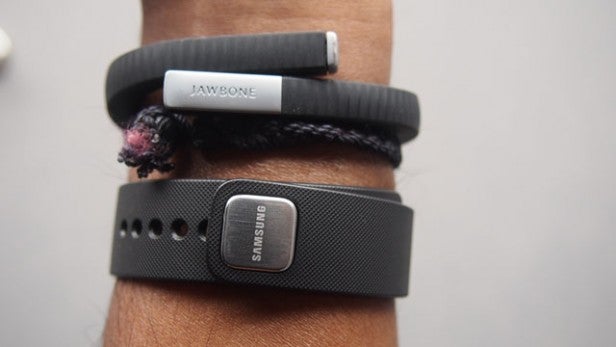
There’s a black bezel and silver trim around the edge of the screen, to mimic the look of Samsung’s Galaxy smartphones and it means the entire display is not fully embraced. It’s still big enough to fit a rich amount of information.
Beneath the screen lies the rubber watch strap which is not too dissimilar to the one used on the Gear 2 albeit with a slightly different dotted pattern. It’s removable simply by pulling it over the top of the screen and can be replaced with a series of additional straps. These however, don’t come in the box and will cost you extra to own.
The strap has a more lightly textured finish on the outside with a grooved design on the inside and a metal clasp to secure fasten into the strap. Like the Fitbit, the pins in the clasp barely pierce through the watch strap holes and with the substantially larger display the watch did actually fall off when brushing past someone.
On the plus side, the Gear Fit proved itself very sturdy given that when it did fall off our wrist, it fell through the gap in an elevator and down the lift shaft and was returned relatively unscathed but for a small chip. This isn’t a usual part of our testing, but the Gear Fit passed the TrustedReviews Elevator Shaft Test with flying colours.
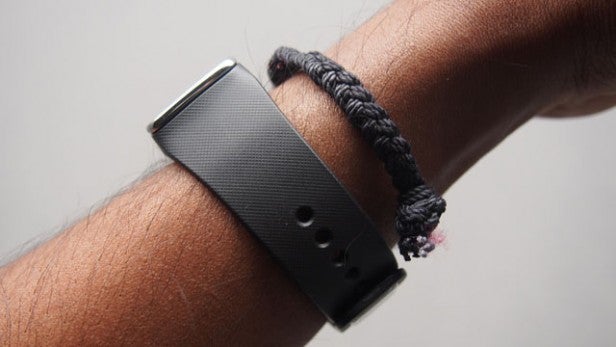
There’s just a single button to turn the screen on and off on the side and underneath, you’ll find the heart rate sensor and the charging pins. Yes, sadly there’s no built-in USB here so you’ll need to clip on the small docking cradle and clip in the standard micro USB charging cable supplied, which means there’s more to carry around.
It weighs 27g and measures in at 11.95mm thick and is surprisingly comfortable to wear. We had no problems even when wearing it day and night for a whole week. Even post-run and gym session, it doesn’t get overly sweaty or sticky and the hypoallergenic strap should ensure you don’t have any adverse skin irritation issues like the ones that caused the Fitbit Force to be recalled recently.
One of the greatest inconsistencies with fitness trackers at the moment is being able to wear them all the time. That means outdoors, in the shower or even in the pool. The Gear Fit has an IP67 certified dust and water-resistant design, which as covered in our IP Ratings explained feature, means it is completely dust-proof and can be submerged up to one metre depth for 30 minutes just like the Samsung Galaxy S5. We took it in the shower and in the bath and it survived although at times it can activate the display, selecting modes without interacting it.
On the whole, we really liked wearing the Gear Fit and while it’s more prominent around the wrist than most fitness trackers, it still has the sleek, stylish look of a watch to give it appeal.
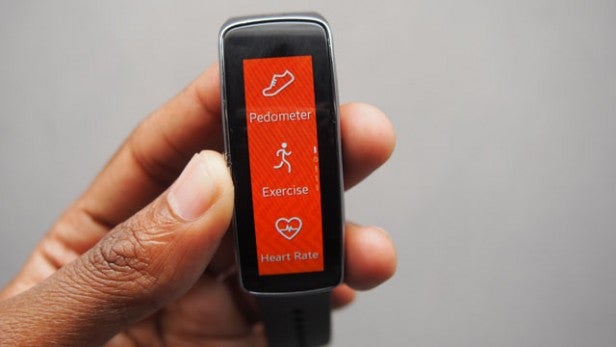
Samsung Gear Fit: Screen
The AMOLED touchscreen display has a 432 x 128 screen resolution, which doesn’t sound all that great, but as an OLED panel it offers excellent brightness and reasonably sharp text. The curved nature of the display means it has a more natural fit around the wrist, but it does mean there are some issues with glare in bright sunlight. Applying the outdoor mode turns on the optimum brightness level for five minutes before going back to default and that certainly helps matters.
In terms of responsiveness, it’s good but not perfect. When you are casually swiping through screens it’s fine but in the midst of a run or even a brisk walk it can become a frustrating experience, selecting a new screen instead of opening a menu.
Our main criticism of the screen initially was the lack of vertical screen orientation support to offer a more natural glance-at-your-watch view. Samsung has since addressed this with a software update, but it’s puzzling to think this wasn’t picked up on in the first place. It does improves things, but elements like the clock faces look squashed and words break lines displaying ‘Notifi-cations’ instead of Notifications, making things a bit messy.


